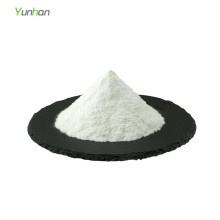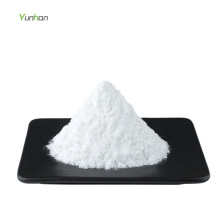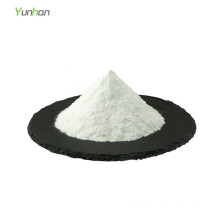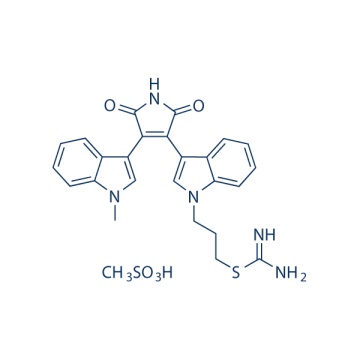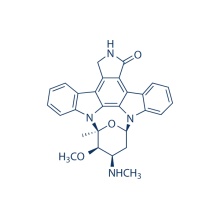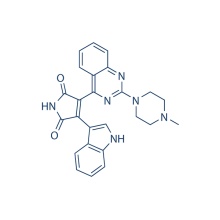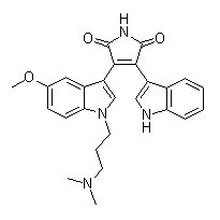Ro 31-8220 Mesylate
Product Description
.cp_wz table {border-top: 1px solid #ccc;border-left:1px solid #ccc; } .cp_wz table td{border-right: 1px solid #ccc; border-bottom: 1px solid #ccc; padding: 5px 0px 0px 5px;} .cp_wz table th {border-right: 1px solid #ccc;border-bottom: 1px solid #ccc; padding: 5px 0px 0px 5px;}
Molecular Weight:
553.65 Ro 31-8220 is a Pan-PKC Inhibitor with IC50 of 5 nM, 24 nM, 14 nM, 27 nM, and 24 nM for PKC-α, PKC-βI, PKC-βII, PKC-γ, and PKC-ε, respectively, and also shows potent inhibition against MAPKAP-K1b, MSK1, GSK3β and S6K1.
Biological Activity
Protocol(Only for Reference)
Kinase Assay: [1]
Cell Assay: [3]
Conversion of different model animals based on BSA (Value based on data from FDA Draft Guidelines)
For example, to modify the dose of resveratrol used for a mouse (22.4 mg/kg) to a dose based on the BSA for a rat, multiply 22.4 mg/kg by the Km factor for a mouse and then divide by the Km factor for a rat. This calculation results in a rat equivalent dose for resveratrol of 11.2 mg/kg.
Chemical Information
Molarity Calculator
Dilution Calculator
Molecular Weight Calculator
Research Area
Customers Who Bought This Item Also Bought
Wortmannin
Wortmannin is the first described PI3K Inhibitor with IC50 of 3 nM, with little selectivity within the PI3K family. Also blocks autophagosome formation and potently inhibits DNA-PK/ATM with IC50 of 16 nM and 150 nM.
ABT-263 (Navitoclax)
ABT-263 (Navitoclax) is a Potent Inhibitor of Bcl-xL, Bcl-2 and Bcl-w with Ki of ≤ 0.5 nM, ≤1 nM and ≤1 nM, but binds more weakly to Mcl-1 and A1. Phase 2.
Dasatinib
Dasatinib is a novel, potent and multi-targeted inhibitor that targets Abl, Src and c-Kit, with IC50 of
Lenalidomide (CC-5013)
Lenalidomide (CC-5013) is a TNF-α secretion inhibitor with IC50 of 13 nM.
Go 6983
Go 6983 is a pan-PKC Inhibitor against for PKCα, PKCβ, PKCγ and PKCδ with IC50 of 7 nM, 7 nM, 6 nM and 10 nM, respectively; less potent to PKCζ and inactive to PKCμ.
Ibrutinib (PCI-32765)
Ibrutinib is a potent and highly selective Brutons tyrosine kinase (Btk) inhibitor with IC50 of 0.5 nM, modestly potent to Bmx, CSK, FGR, BRK, HCK, less potent to EGFR, Yes, ErbB2, JAK3, etc.
Tech Support & FAQs
Answers to questions you may have can be found in the inhibitor handling instructions. Topics include how to prepare stock solutions, how to store Inhibitors, and issues that need special attention for cell-based assays and animal experiments.
Contact us if you need more details on 138489-18-6. We are ready to answer your questions on packaging, logistics, certification or any other aspects about Ro 31-8220 Mesylate 138489-18-6、Ro 31-8220 Mesylate. If these products fail to match your need, please contact us and we would like to provide relevant information.
Molecular Weight:
553.65 Ro 31-8220 is a Pan-PKC Inhibitor with IC50 of 5 nM, 24 nM, 14 nM, 27 nM, and 24 nM for PKC-α, PKC-βI, PKC-βII, PKC-γ, and PKC-ε, respectively, and also shows potent inhibition against MAPKAP-K1b, MSK1, GSK3β and S6K1.
Biological Activity
| Description | Ro 31-8220 is a pan-PKC inhibitor with IC50 of 5 nM, 24 nM, 14 nM, 27 nM, and 24 nM for PKC-α, PKC-βI, PKC-βII, PKC-γ, and PKC-ε, respectively, and also shows potent inhibition against MAPKAP-K1b, MSK1, GSK3β and S6K1. | |||||
|---|---|---|---|---|---|---|
| Targets | PKCα [1] | PKCβ2 [1] | PKCβ1 [1] | PKCε [1] | PKCγ [1] | |
| IC50 | 5 nM | 14 nM | 24 nM | 24 nM | 27 nM | |
| In vitro | Ro 31-8220 inhibits rat brain PKC activity with IC50 of 23 nM, and does not show any high degree of selectivity between PKC-α, PKC-β, PKC-γ, and PKC-ε. Ro 31-8220 also inhibits MSK1, MAPKAPK1, RSK, GSK3β and S6K1 with a potency similar to that for PKC. In addition, Ro 31-8220 inhibits voltage-dependent Na+ channels. Ro 31-8220 alters cellular protein kinase C localization and potently inhibits growth of A549 and MCF-7 cells with IC50 of 0.78 μM and 0.897 μM, respectively. RO 31-8220 enhances epinephrine-induced platelet aggregation in catecholamine hypo-responsive platelets by enhancing Akt phosphorylation. Ro 31-8220 significantly decreases apoE secretion from primary human macrophages by inhibiting vesicular transport of apoE to the plasma membrane without significantly affecting apoE mRNA or apoE protein levels. | |||||
| In vivo | | |||||
| Features | | |||||
Protocol(Only for Reference)
Kinase Assay: [1]
| Assay of PKC Activity | Assay mixtures contain 0.2 mg/mL peptide-gamma, 10 μM MgCl2, 0.6 mM CaCl2, 10 μM [γ-32P]ATP, 1.25 mg/mL phosphatidylserine and 1.25 ng/mL phorbol 12-myristate 13-acetate in 20 mM Hepes (pH 7.5), 2 mM EDTA, 1 mM dithiothreitol and 0.02% (w/v) Triton X-100. Peptide-γ is a synthetic peptide, GPRPLFCRKGSLRQKW, resembling the PKC-γ pseudosubstrate site, except that a serine residue replaces the pseudosubstrate alanine, converting the peptide from an inhibitor into a substrat. The assays are started by the addition of 2.5 m-units of enzyme, incubated at 30 °C for 10 min and terminated by spotting on to P81 paper, followed by extensive washing in 75 mM orthophosphoric acid. The papers are then washed in ethanol, dried, and incorporated radioactivity is determined by liquidscintillation spectroscopy. |
|---|
Cell Assay: [3]
| Cell lines | Human A549 lung and MCF-7 breast carcinoma cells |
|---|---|
| Concentrations | 2.5 μM |
| Incubation Time | 24-48 hours |
| Method | Human A549 lung and MCF-7 breast carcinoma cells are obtained from the European Collection of Animal Cell Cultures. Cells (passage number 10-30) are cultured in an atmosphere of 5% carbon dioxide, the former in Ham's F-12 medium with penicillin/streptomycin, the latter in minimum essential medium (Eagle's modification) with additional pyruvate (1 mM) and non-essential Amino Acids. Both media are supplemented with 10% FCS and glutamine (2 mM). Cells are subcultured routinely twice weekly to maintain logarithmic growth. For cell proliferation studies cells are seeded and incubated with 3 ml of medium including agents, which is replenished at intervals of 48 h (A549) or 72 h (MCF-7). Following incubation for 4 days (A549) or 6 days (MCF-7) with drugs, cell number is assessed using a Coulter Counter Model ZM. In order to achieve PKC depletion, cells are incubated for 24 h with bryostatin 1 (1 μM). Under these conditions growth inhibition caused by bryostatin 1 is negligible. Bryostatin is removed by extensive washing of the cells followed by a 2 h recovery period. In previous work using the A549 cell line this washing procedure has been shown to eliminate bryostatin-mediated effects. The cells are then incubated for a further 24 h with staurosporine, RO 31-8220, UCN-01 or H-7. In some experiments cells are incubated with inhibitor for 48 rather than 24 h, in this case bryostation was not removed and left in the incubate. After removal of agents inhibition of DNA synthesis is evaluated by measurement of [3H]Tdr incorporation into cell. Radioactivity is counted using a Packard 1500 Tricarb scintillation counter. |
Conversion of different model animals based on BSA (Value based on data from FDA Draft Guidelines)
| Species | Baboon | Dog | Monkey | Rabbit | Guinea pig | Rat | Hamster | Mouse |
| Weight (kg) | 12 | 10 | 3 | 1.8 | 0.4 | 0.15 | 0.08 | 0.02 |
| Body Surface Area (m2) | 0.6 | 0.5 | 0.24 | 0.15 | 0.05 | 0.025 | 0.02 | 0.007 |
| Km factor | 20 | 20 | 12 | 12 | 8 | 6 | 5 | 3 |
| Animal A (mg/kg) = Animal B (mg/kg) multiplied by | Animal B Km |
| Animal A Km |
For example, to modify the dose of resveratrol used for a mouse (22.4 mg/kg) to a dose based on the BSA for a rat, multiply 22.4 mg/kg by the Km factor for a mouse and then divide by the Km factor for a rat. This calculation results in a rat equivalent dose for resveratrol of 11.2 mg/kg.
| Rat dose (mg/kg) = mouse dose (22.4 mg/kg) × | mouse Km(3) | = 11.2 mg/kg |
| rat Km(6) |
Chemical Information
| Molecular Weight (MW) | 553.65 |
|---|---|
| Formula | C25H23N5O2S.CH4O3S |
| CAS No. | 138489-18-6 |
| Storage | 3 years -20℃Powder |
|---|---|
| 6 months-80℃in solvent (DMSO, water, etc.) | |
| Synonyms | Bisindolylmaleimide IX Mesylate |
| Solubility (25°C) * | In vitro | DMSO | 100 mg/mL (180.61 mM) |
|---|---|---|---|
| Water | <1 mg/mL ( | ||
| Ethanol | <1 mg/mL ( | ||
| * <1 mg/ml means slightly soluble or insoluble. * Please note that Selleck tests the solubility of all compounds in-house, and the actual solubility may differ slightly from published values. This is normal and is due to slight batch-to-batch variations. | |||
| Chemical Name | Carbamimidothioic acid, 3-[3-[2,5-dihydro-4-(1-methyl-1H-indol-3-yl)-2,5-dioxo-1H-pyrrol-3-yl]-1H-indol-1-yl]propyl ester, methanesulfonate (1:1) |
|---|
Molarity Calculator
Dilution Calculator
Molecular Weight Calculator
Research Area
Customers Who Bought This Item Also Bought
Wortmannin
Wortmannin is the first described PI3K Inhibitor with IC50 of 3 nM, with little selectivity within the PI3K family. Also blocks autophagosome formation and potently inhibits DNA-PK/ATM with IC50 of 16 nM and 150 nM.
ABT-263 (Navitoclax)
ABT-263 (Navitoclax) is a Potent Inhibitor of Bcl-xL, Bcl-2 and Bcl-w with Ki of ≤ 0.5 nM, ≤1 nM and ≤1 nM, but binds more weakly to Mcl-1 and A1. Phase 2.
Dasatinib
Dasatinib is a novel, potent and multi-targeted inhibitor that targets Abl, Src and c-Kit, with IC50 of
Lenalidomide (CC-5013)
Lenalidomide (CC-5013) is a TNF-α secretion inhibitor with IC50 of 13 nM.
Go 6983
Go 6983 is a pan-PKC Inhibitor against for PKCα, PKCβ, PKCγ and PKCδ with IC50 of 7 nM, 7 nM, 6 nM and 10 nM, respectively; less potent to PKCζ and inactive to PKCμ.
Ibrutinib (PCI-32765)
Ibrutinib is a potent and highly selective Brutons tyrosine kinase (Btk) inhibitor with IC50 of 0.5 nM, modestly potent to Bmx, CSK, FGR, BRK, HCK, less potent to EGFR, Yes, ErbB2, JAK3, etc.
Tech Support & FAQs
Answers to questions you may have can be found in the inhibitor handling instructions. Topics include how to prepare stock solutions, how to store Inhibitors, and issues that need special attention for cell-based assays and animal experiments.
Contact us if you need more details on 138489-18-6. We are ready to answer your questions on packaging, logistics, certification or any other aspects about Ro 31-8220 Mesylate 138489-18-6、Ro 31-8220 Mesylate. If these products fail to match your need, please contact us and we would like to provide relevant information.
Product Categories : Cytoskeletal Signaling > PKC Inhibitor
Other Products
Hot Products
Astragaloside AChlortetracycline HCl 64-72-2Paclitaxel 33069-62-4Dexamethasone Acetate 1177-87-3Dinaciclib (SCH727965) 779353-01-4CHIR-124 405168-58-3Ro3280 1062243-51-9TAME 901-47-3CCG-1423 285986-88-110058-F4 403811-55-2Dabigatran (BIBR 953) 211914-51-1H 89 2HCl 130964-39-5T0901317 293754-55-9Aprepitant 170729-80-3Turofexorate Isopropyl (XL335) 629664-81-9BMS-378806 357263-13-9
